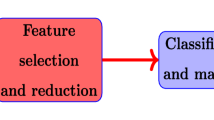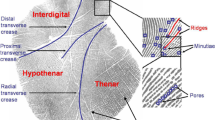Abstract
Palm print identification is a biometric technique that relies on the distinctive characteristics of a person’s palm print to distinguish and authenticate their identity. The unique pattern of ridges, lines, and other features present on the palm allows for the identification of an individual. The ridges and lines on the palm are formed during embryonic development and remain relatively unchanged throughout a person’s lifetime, making palm prints an ideal candidate for biometric identification. Using deep learning networks, such as GoogLeNet, SqueezeNet, and AlexNet combined with gray wolf optimization, we achieved to extract and analyze the unique features of a person’s palm print to create a digital representation that can be used for identification purposes with a high degree of accuracy. To this end, two well-known datasets, the Hong Kong Polytechnic University dataset and the Tongji Contactless dataset, were used for testing and evaluation. The recognition rate of the proposed method was compared with other existing methods such as principal component analysis, including local binary pattern and Laplacian of Gaussian-Gabor transform. The results demonstrate that the proposed method outperforms other methods with a recognition rate of 96.72%. These findings show that the combination of deep learning and gray wolf optimization can effectively improve the accuracy of human identification using palm print images.















Similar content being viewed by others
Availability of data and materials
The datasets used in the research are publicly available for download.
References
Balasubramanian, K.: Cryptographic Solutions for Secure Online Banking and Commerce. IGI Global, Pennsylvania (2016)
Adhinagara, Y., Agung, B.W.T., Novi, D.R.: Implementation of multimodal biometrics recognition system combined palm print and palm geometry features. In: Proceedings of the 2011 International Conference on Electrical Engineering and Informatics, pp. 1–5 (2011)
Winn, J.K.: Couriers without luggage: Negotiable instruments and digital signatures. SCL Rev. 49, 739 (1997)
Matheswaran, P., Navaneethan, C., Meenatchi, S., Ananthi, S., Janaki, K., Manjunathan, A., “Image Privacy in Social Network Using Invisible Watermarking Techniques,” Ann. Rom. Soc. Cell Biol., pp. 319–327, 2021.
Raut, S.D., Humbe, V.T., Mane, A.V.: Development of biometrie palm vein trait based person recognition system: Palm vein biometrics system. In 2017 1st international conference on intelligent systems and information management (ICISIM), pp. 18–21 (2017)
Venkateswaran, R.: Virtual private networks. IEEE Potentials 20(1), 11–15 (2001)
Sato, T., Aoyama, S., Sakai, S., Yusa, S., Ito, K., Aoki, T.: A contactless palm recognition system using simple active 3D measurement with diffraction grating laser. In: 2013 2nd IAPR Asian conference on pattern recognition, pp. 542–546 (2013)
Trabelsi, S., Samai, D., Dornaika, F., Benlamoudi, A., Bensid, K., Taleb-Ahmed, A.: Efficient palmprint biometric identification systems using deep learning and feature selection methods. Neural Comput. Appl. 34(14), 12119–12141 (2022)
Türk, Ö., Çalışkan, A., Acar, E., Ergen, B.: Palmprint recognition system based on deep region of interest features with the aid of hybrid approach. Signal, Image Video Process 17, 1–9 (2023)
Zhou, Q., Jia, W., Yu, Y.: Multi-stream convolutional neural networks fusion for palmprint recognition. In: Chinese Conference on Biometric Recognition pp. 72–81 (2022)
Fan, Y., Li, J., Song, S., Zhang, H., Wang, S., Zhai, G.: Palmprint phenotype feature extraction and classification based on deep learning. Phenomics 2(4), 219–229 (2022)
Ahmed, S., Frikha, M., Hussein, T.D.H., Rahebi, J.: Harris Hawks optimization method based on convolutional neural network for face recognition systems. In: 2022 International Congress on Human-Computer Interaction, Optimization and Robotic Applications (HORA), pp. 1–6 (2022)
Ahmed, S., Frikha, M., Hussein, T.D.H., Rahebi, J.: Face recognition system using histograms of oriented gradients and convolutional neural network based on with particle swarm optimization. In: 2021 International Conference on Electrical, Communication, and Computer Engineering (ICECCE), pp. 1–5 (2021)
Abdoun, N., El Assad, S., Assaf, R., Déforges, O., Khalil, M., Belghith, S.: Design and implementation of robust Keyed Hash functions based on Chaotic Neural Network (2018)
Srivastava, N., Hinton, G., Krizhevsky, A., Sutskever, I., Salakhutdinov, R.: Dropout: a simple way to prevent neural networks from overfitting. J. Mach. Learn. Res. 15(1), 1929–1958 (2014)
Kingma, D.P., Ba, J.: Adam: A Method for Stochastic Optimization. arXiv Prepr. arXiv1412.6980 (2014)
Glorot, X., Bengio, Y.: Understanding the difficulty of training deep feedforward neural networks. In: Proceedings of the Thirteenth International Conference on Artificial Intelligence and Statistics, pp. 249–256 (2010).
Krizhevsky, A., Sutskever, I., Hinton, G.E.: ImageNet classification with deep convolutional neural networks. Commun. ACM 60(6), 84–90 (2017)
Shin, H.-C., et al.: Deep convolutional neural networks for computer-aided detection: CNN architectures, dataset characteristics and transfer learning. IEEE Trans. Med. Imaging 35(5), 1285–1298 (2016)
Szegedy, C., Vanhoucke, V., Ioffe, S., Shlens, J., Wojna, Z.: Rethinking the inception architecture for computer vision. In: Proceedings of the IEEE Conference on Computer Vision and Pattern Recognition, pp. 2818–2826 (2016)
Konda, K.R.: Unsupervised Relational Feature Learning for Vision. Univ.-Bibliothek, Frankfurt am Main (2016)
Sethi, I.K., Jain, A.K.: Artificial Neural Networks and Statistical Pattern Recognition: Old and New Connections. Elsevier, Amsterdam (2014)
Hecht-Nielsen, R.: Theory of the backpropagation neural network. In: Neural Networks for Perception, Elsevier, Amsterdam, pp. 65–93 (1992)
Miikkulainen, R., et al.: Evolving deep neural networks. In: Artificial Intelligence in the Age of Neural Networks and Brain Computing. Elsevier, Amsterdam, pp. 293–312 (2019)
Schmidhuber, J.: Deep learning in neural networks: an overview. Neural Netw. 61, 85–117 (2015)
Torrey, L., Shavlik, J.: Transfer learning. In: Handbook of Research on Machine Learning Applications and Trends: Algorithms, Methods, and Techniques. IGI Global, pp. 242–264 (2010)
Tan, C., Sun, F., Kong, T., Zhang, W., Yang, C., Liu, C.: A survey on deep transfer learning. In: International Conference on Artificial Neural Networks, pp. 270–279 (2018)
Ravishankar, H., et al.: Understanding the mechanisms of deep transfer learning for medical images. In: Deep Learning and Data Labeling for Medical Applications. Springer, Berlin, pp. 188–196 (2016)
Yin, X., Yu, X., Sohn, K., Liu, X., Chandraker, M.: Feature transfer learning for face recognition with under-represented data. In: Proceedings of the IEEE/CVF Conference on Computer Vision and Pattern Recognition, pp. 5704–5713 (2019)
Gopalakrishnan, K., Khaitan, S.K., Choudhary, A., Agrawal, A.: Deep convolutional neural networks with transfer learning for computer vision-based data-driven pavement distress detection. Constr. Build. Mater. 157, 322–330 (2017)
Yu, Y., Lin, H., Meng, J., Wei, X., Guo, H., Zhao, Z.: Deep transfer learning for modality classification of medical images. Information 8(3), 91 (2017)
Xin, Z.D.P., Xin, P., Xiaoling, L., Xiaojing, G.: Palmprint recognition based on deep learning (2015)
Alom, M.Z., et al.: The history began from alexnet: a comprehensive survey on deep learning approaches. arXiv Prepr. arXiv1803.01164 (2018)
Koonce, B.: “SqueezeNet” In Convolutional Neural Networks with Swift for Tensorflow, Springer, Amsterdam, pp. 73–85 (2021). https://doi.org/10.1049/cp.2015.0942
Mirjalili, S., Mirjalili, S.M., Lewis, A.: Grey wolf optimizer. Adv. Eng. Softw. 69, 46–61 (2014)
Zhang, L., Li, L., Yang, A., Shen, Y., Yang, M.: Towards contactless palmprint recognition: a novel device, a new benchmark, and a collaborative representation based identification approach. Pattern Recognit. 69, 199–212 (2017)
Jamshidnezhad, A., Nordin, M.J.: A classifier model based on the features quantitative analysis for facial expression recognition. Int. J. Adv. Sci. Eng. Inf. Technol. 1(4), 391–394 (2011)
Koelstra, S., Pantic, M., Patras, I.: A dynamic texture-based approach to recognition of facial actions and their temporal models. IEEE Trans. Pattern Anal. Mach. Intell. 32(11), 1940–1954 (2010)
Yang, P., Liu, Q., Metaxas, D.N.: Boosting encoded dynamic features for facial expression recognition. Pattern Recognit. Lett. 30(2), 132–139 (2009)
Thai, L.H., Nguyen, N.D.T., Hai, T.S.: A facial expression classification system integrating canny, principal component analysis and artificial neural network. arXiv Prepr arXiv1111.4052 (2011)
Singh, G., Singh, B.: Feature based method for human facial emotion detection using optical flow based analysis. Int. J. Eng. Sci. 4, 363–372 (2011)
PolyU palmprint database. http://www4.comp.polyu.edu.hk/~biometrics/. Accessed in June 2017
Funding
The authors received no financial support for the research, authorship, and/or publication of this article.
Author information
Authors and Affiliations
Contributions
The authors have contributed equally to the paper.
Corresponding author
Ethics declarations
Conflict of interests
The authors have no relevant financial or non-financial interests to disclose.
Ethical approval
This research does not require ethics approval.
Consent to participate
This research uses publicly available anonymous data.
Consent for publication
This research does not contain any individual’s data.
Additional information
Publisher's Note
Springer Nature remains neutral with regard to jurisdictional claims in published maps and institutional affiliations.
Rights and permissions
Springer Nature or its licensor (e.g. a society or other partner) holds exclusive rights to this article under a publishing agreement with the author(s) or other rightsholder(s); author self-archiving of the accepted manuscript version of this article is solely governed by the terms of such publishing agreement and applicable law.
About this article
Cite this article
Alshakree, F., Akbas, A. & Rahebi, J. Human identification using palm print images based on deep learning methods and gray wolf optimization algorithm. SIViP 18, 961–973 (2024). https://doi.org/10.1007/s11760-023-02787-6
Received:
Revised:
Accepted:
Published:
Issue Date:
DOI: https://doi.org/10.1007/s11760-023-02787-6




